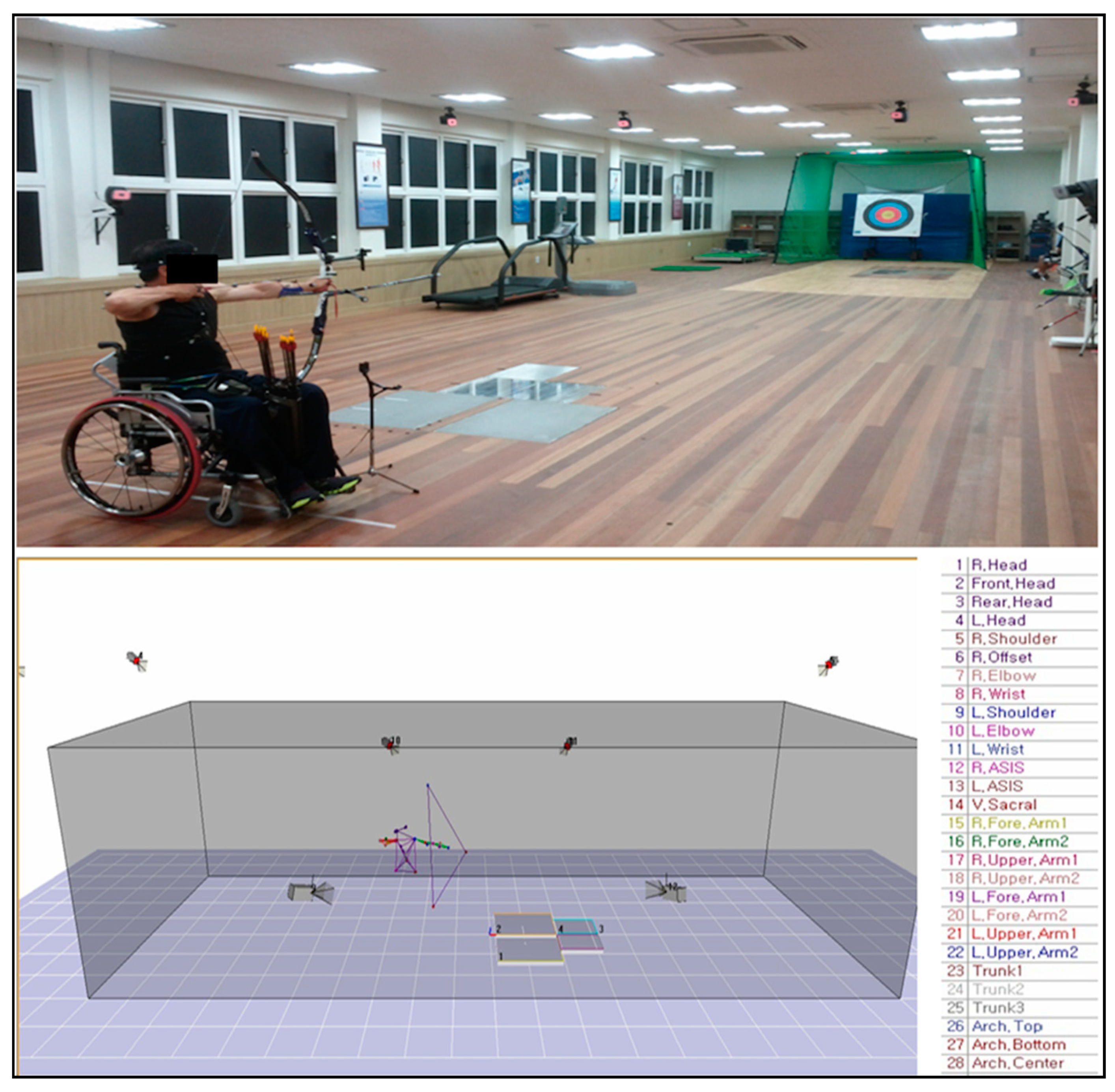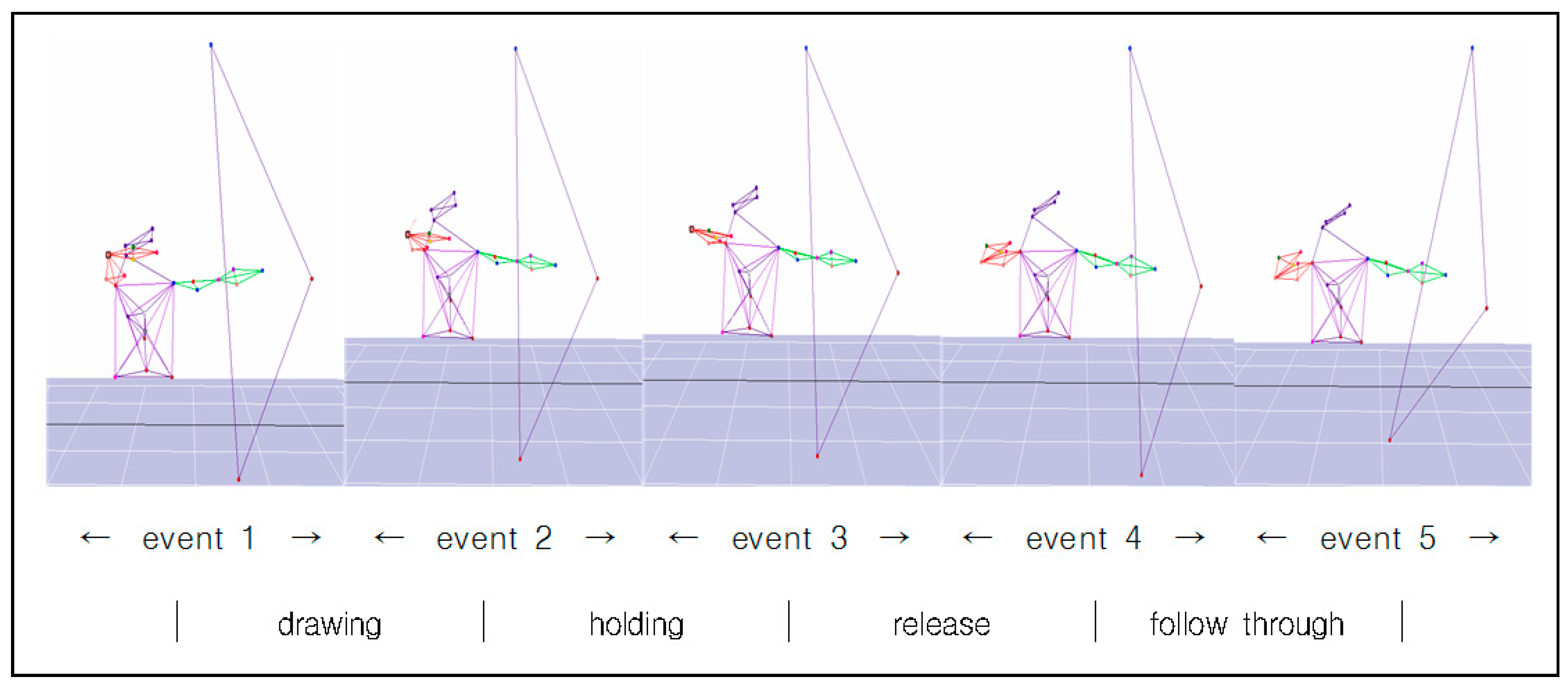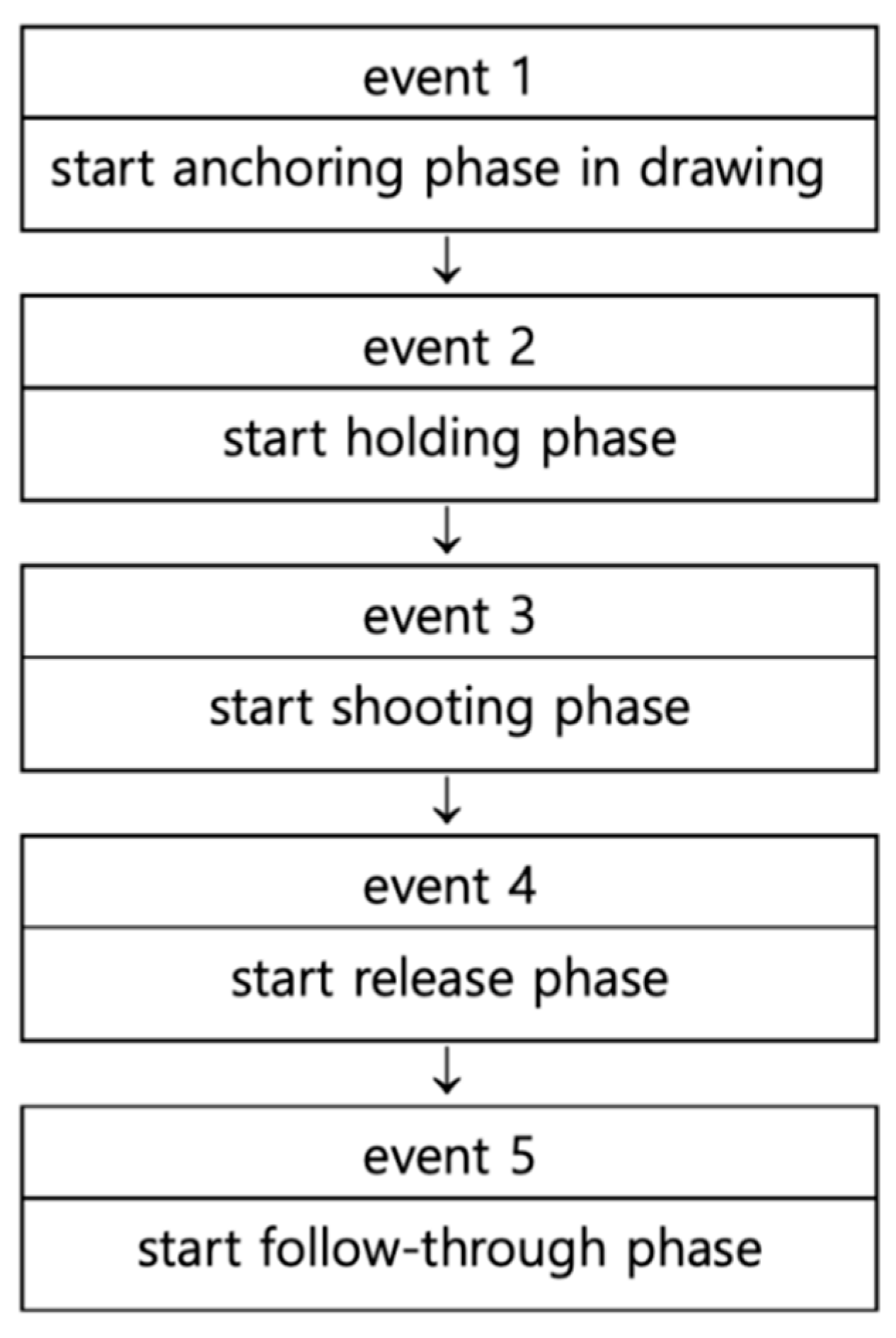A Feasibility Study of Kinematic Characteristics on the Upper Body According to the Shooting of Elite Disabled Archery Athletes
Abstract
1. Introduction
2. Materials and Methods
- Drawing phase: From the starting point of the drawing to the starting point of the anchoring, which is the moment when the pulling arm started from pulled to stopped completely.
- Holding phase: From the beginning of holding to the moment when the finger holding the loosen starts releasing.
- Release phase: From the start of the release to the beginning of the follow-through, which is the moment when the arrow has completely deviated from the bow.
- Follow-through phase: From the start of the follow-through to its end, i.e., after the end of the rotating bow passes through the waist.
3. Results
3.1. Time Required for Each Phase
3.2. The Body’s Angle of Inclination by Each Event
3.3. Change of the Center of the Upper Body’s Trajectory by Phase
3.4. Change of the Movement Trajectory of the Center of the Bow by Phase
4. Discussion
5. Conclusions
Author Contributions
Funding
Institutional Review Board Statement
Informed Consent Statement
Data Availability Statement
Acknowledgments
Conflicts of Interest
References
- Ha, C.S.; Shin, M.H.; Kim, B.G. Analysis of ground reaction force set up to shooting position for improve performance archers. Korean J. Sport Sci. 2006, 15, 817–828. [Google Scholar]
- Korean Paralympic Committee. 10 Years of Korean Physical Education Association; Korean Paralympic Committee: Seoul, Korea, 2015. [Google Scholar]
- Kim, B.H.; Song, J.H.; Kim, K.J. Archery Training Guide for the Disabled to Improve Performance; Korean Paralympic Committee: Seoul, Korea, 2008. [Google Scholar]
- World Archery. Para Archery Classified Handbook; World Archery: Lausanne, Switzerland, 2020. [Google Scholar]
- Kim, J.T.; Lee, S.J.; Kim, S.S. Influence of rating of perceived exertion on kinematic characteristics in top class archery athletes. J. CoA Dev. 2014, 16, 99–106. [Google Scholar]
- Hah, C.K.; Yi, J.H. Evaluation on kinematic factors affecting scores of Olympic round game during the follow through in archery. Korean J. Sport Biomech. 2008, 18, 227–234. [Google Scholar]
- Kim, J.H.; Kim, H.Y. Kinematic analysis on the release movement for expert archers. Korean J. Phys. Educ. 2005, 44, 415–424. [Google Scholar]
- Kim, J.H. The Effect of the Perception of Rhythm of Clicker Sound on Archer’s Records. Master’s Thesis, Korea National Sport University Graduate School, Seoul, Korea, 1996. Unpublished paper. [Google Scholar]
- Stuart, J.; Atha, J. Postural consistency in skilled archers. J. Sport Sci. 1990, 8, 223–234. [Google Scholar] [CrossRef] [PubMed]
- Lakens, D. Calculating and reporting effect sizes to facilitate cumulative science: A practical primer for t-tests and ANOVAs. Front. Psychol. 2013, 4, 863. [Google Scholar] [CrossRef] [PubMed]
- Kim, H.Y.; Kim, J.H. The consistency of an elite archer’s shooting movement for improving his performance. Korean J. Phys. Educ. 2006, 45, 473–483. [Google Scholar]
- Lee, J.H.; Hah, C.K.; Ryu, J.S.; Kim, K.C. Evaluation on motion features of the world’s second archer during back-tension in archery. Korean J. Sport Biomech. 2007, 17, 197–207. [Google Scholar]
- Kim, J.P. The Correlation of the physical stability and the performance of archers in non-shooting and shooting. Korean J. Sport Biomech. 2000, 10, 133–147. [Google Scholar]
- Kim, J.P. The effect of balance exercise on postural control and shooting record in archers. Korean J. Sport Biomech. 2008, 18, 65–74. [Google Scholar] [CrossRef][Green Version]



| Group | Ages (y) | Classification | Length of Arm (cm) |
|---|---|---|---|
| Male | 45 | ARW2 | 69.9 |
| Male | 43 | ARW2 | 71.1 |
| Male | 52 | ARW2 | 74.9 |
| Female | 46 | ARW2 | 72.4 |
| Male | 51 | ARST | 69.2 |
| Female | 47 | ARST | 66.0 |
| Female | 46 | ARST | 69.9 |
| Division | Experiment Equipment | Manufacture Company |
|---|---|---|
| Calculation and Acquisition of Spatial Coordinates | NLT | Motion Analysis |
| Reflection Marker (12.7 mm) | ||
| Motion Shooting | Motion Capture System | Motion Analysis |
| Motion Analysis | Motion Analysis Software (Cortex 1.3) | Motion Analysis |
| Dependent Variable (s) | Groups | Mean | Standard Deviation | t | p | Effect Size | 95% Confidence Interval of Difference | ||
|---|---|---|---|---|---|---|---|---|---|
| Lower | Upper | ||||||||
| Time required by each phase | Drawing | ARW2 | 2.23 | 0.52 | 3.703 * | 0.014 | 2.359 | 0.371 | 2.109 |
| ARST | 0.99 | 0.29 | |||||||
| Holding | ARW2 | 4.41 | 0.85 | 2.619 * | 0.047 | 1.674 | 0.018 | 2.722 | |
| ARST | 3.04 | 0.32 | |||||||
| Release | ARW2 | 0.30 | 0.04 | −0.452 | 0.670 | −0.221 | −0.130 | 0.170 | |
| ARST | 0.32 | 0.11 | |||||||
| Follow Through | ARW2 | 0.34 | 0.06 | −1.546 | 0.183 | −0.975 | −0.118 | 0.458 | |
| ARST | 0.51 | 0.22 | |||||||
| Dependent Variable (Degree) | Events | Groups | Mean | Standard Deviation | t | p | Effect Size | 95% Confidence Interval of Difference | |
|---|---|---|---|---|---|---|---|---|---|
| Lower | Upper | ||||||||
| The angle of inclination of the body by event (anterior and posterior) | E1 | ARW2 | 70.65 | 5.12 | −1.843 | 0.124 | −1.193 | −2.390 | 14.810 |
| ARST | 76.86 | 2.94 | |||||||
| E2 | ARW2 | 70.50 | 6.22 | −1.588 | 0.173 | −1.019 | −3.877 | 16.357 | |
| ARST | 76.74 | 2.89 | |||||||
| E3 | ARW2 | 70.49 | 6.94 | −1.555 | 0.181 | −0.999 | −4.42 | 17.94 | |
| ARST | 77.25 | 2.97 | |||||||
| E4 | ARW2 | 69.71 | 6.97 | −1.518 | 0.19 | −0.975 | −4.997 | 19.397 | |
| ARST | 76.91 | 4.86 | |||||||
| E5 | ARW2 | 69.15 | 7.35 | −1.464 | 0.203 | −0.941 | −5.417 | 19.757 | |
| ARST | 76.32 | 4.66 | |||||||
| The angle of inclination of the body by event (left and right) | E1 | ARW2 | 8.73 | 2.33 | 0.572 | 0.592 | 0.367 | −5.179 | 8.139 |
| ARST | 7.25 | 4.54 | |||||||
| E2 | ARW2 | 9.70 | 5.89 | 0.26 | 0.805 | 0.169 | −9.160 | 11.240 | |
| ARST | 8.66 | 3.93 | |||||||
| E3 | ARW2 | 9.80 | 4.66 | 0.244 | 0.817 | 0.157 | −8.114 | 9.814 | |
| ARST | 8.95 | 4.42 | |||||||
| E4 | ARW2 | 7.97 | 3.63 | 0.046 | 0.965 | 0.029 | −7.238 | 7.498 | |
| ARST | 7.84 | 3.93 | |||||||
| E5 | ARW2 | 9.55 | 2.28 | −0.045 | 0.966 | −0.028 | −6.841 | 7.081 | |
| ARST | 9.67 | 4.86 | |||||||
| Dependent Variable (m·s−1) | Groups | Mean | Standard Deviation | t | p | Effect Size | 95% Confidence Interval of Difference | ||
|---|---|---|---|---|---|---|---|---|---|
| Lower | Upper | ||||||||
| Change of trajectory of body center | drawing_X | ARW2 | 1.86 | 0.37 | 2.297 | 0.07 | 1.435 | −0.115 | 1.635 |
| ARST | 1.10 | 0.54 | |||||||
| drawing_Y | ARW2 | 1.01 | 0.29 | 3.523 * | 0.017 | 2.236 | 0.188 | 1.252 | |
| ARST | 0.29 | 0.24 | |||||||
| drawing_Z | ARW2 | 5.52 | 1.78 | 0.972 | 0.376 | 0.624 | −2.161 | 4.781 | |
| ARST | 4.21 | 1.75 | |||||||
| holding_X | ARW2 | 0.74 | 0.10 | 0.38 | 0.72 | 0.263 | −0.159 | 0.219 | |
| ARST | 0.71 | 0.09 | |||||||
| holding_Y | ARW2 | 0.38 | 0.31 | 0.784 | 0.469 | 0.522 | −0.369 | 0.709 | |
| ARST | 0.21 | 0.21 | |||||||
| holding_Z | ARW2 | 1.32 | 1.62 | 0.221 | 0.834 | 0.146 | −2.370 | 2.830 | |
| ARST | 1.09 | 0.67 | |||||||
| release_X | ARW2 | 1.46 | 0.35 | 0.098 | 0.926 | 0.083 | −0.563 | 0.623 | |
| ARST | 1.43 | 0.21 | |||||||
| release_Y | ARW2 | 0.30 | 0.19 | 0.5 | 0.638 | 0.294 | −0.277 | 0.397 | |
| ARST | 0.24 | 0.14 | |||||||
| release_Z | ARW2 | 0.99 | 0.15 | −0.884 | 0.417 | −0.570 | −0.683 | 1.403 | |
| ARST | 1.35 | 0.82 | |||||||
| Follow through_X | ARW2 | 1.73 | 0.12 | −1.282 | 0.328 | −0.985 | −1.091 | 4.311 | |
| ARST | 3.34 | 2.17 | |||||||
| Follow through_Y | ARW2 | 0.65 | 0.43 | −0.937 | 0.392 | −0.604 | −0.485 | 1.045 | |
| ARST | 0.93 | 0.32 | |||||||
| Follow through_Z | ARW2 | 2.27 | 0.65 | −1.368 | 0.23 | −0.877 | −0.796 | 2.596 | |
| ARST | 3.17 | 1.11 | |||||||
| Dependent Variable (m·s−1) | Groups | Mean | Standard Deviation | t | p | Effect Size | 95% Confidence Interval of Difference | ||
|---|---|---|---|---|---|---|---|---|---|
| Lower | Upper | ||||||||
| Change of the movement trajectory of the bow center | drawing_X | ARW2 | 0.63 | 0.24 | 1.489 | 0.197 | 0.941 | −0.182 | 0.662 |
| ARST | 0.39 | 0.17 | |||||||
| drawing_Y | ARW2 | 0.25 | 0.15 | 0.312 | 0.768 | 0.199 | −0.219 | 0.279 | |
| ARST | 0.22 | 0.08 | |||||||
| drawing_Z | ARW2 | 0.92 | 0.33 | 1.436 | 0.21 | 0.942 | −0.257 | 0.937 | |
| ARST | 0.58 | 0.26 | |||||||
| holding_X | ARW2 | 0.21 | 0.08 | −1.305 | 0.249 | −0.754 | −1.279 | 1.340 | |
| ARST | 0.27 | 0.04 | |||||||
| holding_Y | ARW2 | 0.11 | 0.10 | 0.151 | 0.886 | 0.100 | −0.154 | 0.174 | |
| ARST | 0.10 | 0.05 | |||||||
| holding_Z | ARW2 | 0.17 | 0.14 | 0.019 | 0.985 | 0.000 | −0.241 | 0.241 | |
| ARST | 0.17 | 0.09 | |||||||
| release_X | ARW2 | 0.31 | 0.30 | 0.706 | 0.511 | 0.467 | −0.330 | 0.590 | |
| ARST | 0.18 | 0.05 | |||||||
| release_Y | ARW2 | 0.20 | 0.15 | 0.91 | 0.405 | 0.637 | −0.144 | 0.324 | |
| ARST | 0.11 | 0.04 | |||||||
| release_Z | ARW2 | 0.24 | 0.10 | 0.081 | 0.939 | 0.063 | −0.250 | 0.270 | |
| ARST | 0.23 | 0.17 | |||||||
| Follow through_X | ARW2 | 0.42 | 0.25 | −0.813 | 0.453 | −0.494 | −0.305 | 0.565 | |
| ARST | 0.55 | 0.17 | |||||||
| Follow through_Y | ARW2 | 0.23 | 0.20 | −0.292 | 0.782 | −0.182 | −0.403 | 0.503 | |
| ARST | 0.28 | 0.27 | |||||||
| Follow through_Z | ARW2 | 0.09 | 0.05 | −0.969 | 0.432 | −0.726 | −0.268 | 0.688 | |
| ARST | 0.30 | 0.38 | |||||||
Publisher’s Note: MDPI stays neutral with regard to jurisdictional claims in published maps and institutional affiliations. |
© 2021 by the authors. Licensee MDPI, Basel, Switzerland. This article is an open access article distributed under the terms and conditions of the Creative Commons Attribution (CC BY) license (http://creativecommons.org/licenses/by/4.0/).
Share and Cite
Kim, T.-W.; Lee, J.-W.; Kang, S.-K.; Chae, K.-Y.; Choi, S.-H.; Song, Y.-G. A Feasibility Study of Kinematic Characteristics on the Upper Body According to the Shooting of Elite Disabled Archery Athletes. Int. J. Environ. Res. Public Health 2021, 18, 2962. https://doi.org/10.3390/ijerph18062962
Kim T-W, Lee J-W, Kang S-K, Chae K-Y, Choi S-H, Song Y-G. A Feasibility Study of Kinematic Characteristics on the Upper Body According to the Shooting of Elite Disabled Archery Athletes. International Journal of Environmental Research and Public Health. 2021; 18(6):2962. https://doi.org/10.3390/ijerph18062962
Chicago/Turabian StyleKim, Tae-Whan, Jae-Won Lee, Seoung-Ki Kang, Kyu-Yeon Chae, Sang-Hyup Choi, and Yong-Gwan Song. 2021. "A Feasibility Study of Kinematic Characteristics on the Upper Body According to the Shooting of Elite Disabled Archery Athletes" International Journal of Environmental Research and Public Health 18, no. 6: 2962. https://doi.org/10.3390/ijerph18062962
APA StyleKim, T.-W., Lee, J.-W., Kang, S.-K., Chae, K.-Y., Choi, S.-H., & Song, Y.-G. (2021). A Feasibility Study of Kinematic Characteristics on the Upper Body According to the Shooting of Elite Disabled Archery Athletes. International Journal of Environmental Research and Public Health, 18(6), 2962. https://doi.org/10.3390/ijerph18062962







